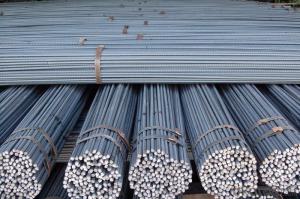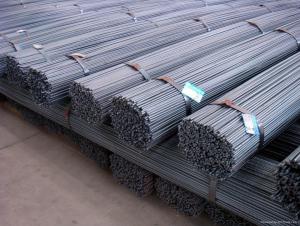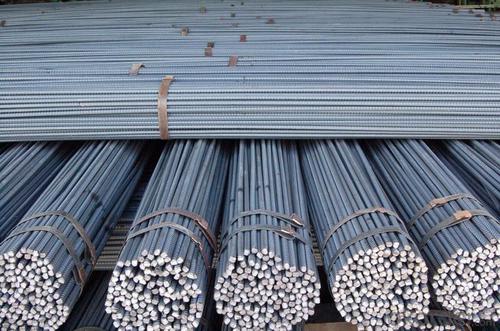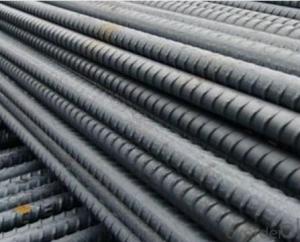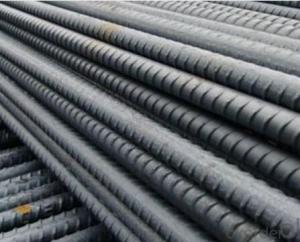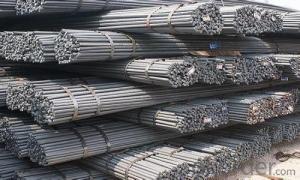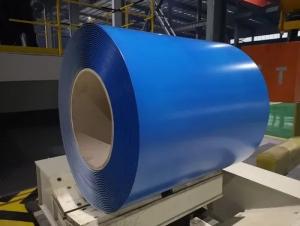Reinforcing Bar for Sale - High Quality Hot Rolled Rebars at Best Prices
- Loading Port:
- Tianjin
- Payment Terms:
- TT OR LC
- Min Order Qty:
- 25 m.t.
- Supply Capability:
- 10000 m.t./month
OKorder Service Pledge
OKorder Financial Service
You Might Also Like
OKorder is offering high quality Hot Rolled Rebars at great prices with worldwide shipping. Our supplier is a world-class manufacturer of steel, with our products utilized the world over. OKorder annually supplies products to European, North American and Asian markets. We provide quotations within 24 hours of receiving an inquiry and guarantee competitive prices.
Product Applications:
Deformed bar is widely used in buildings, bridges, roads and other engineering construction. Big to highways, railways, bridges, culverts, tunnels, public facilities such as flood control, dam, small to housing construction, beam, column, wall and the foundation of the plate, deformed bar is an integral structure material. With the development of world economy and the vigorous development of infrastructure construction, real estate, the demand for deformed bar will be larger and larger..
Label: to be specified by customer, generally, each bundle has 1-2 labels
Product Advantages:
OKorder's Hot Rolled Rebars are durable, strong, and resist corrosion.
Main Product Features:
· Premium quality
· Prompt delivery & seaworthy packing (30 days after receiving deposit)
· Corrosion resistance
· Can be recycled and reused
· Mill test certification
· Professional Service
· Competitive pricing
Product Specifications:
Manufacture: Hot rolled
Grade: HRB400 – HRB500
Certificates: ISO, SGS, BV, CIQ
Length: 6m – 12m, as per customer request
Packaging: Export packing, nude packing, bundled
Grade | Technical data of the original chemical composition (%) | ||||||
C | Mn | Si | S | P | V | ||
HRB400 | ≤0.25 | ≤1.60 | ≤0.80 | ≤0.045 | ≤0.045 | 0.04-0.12 | |
Physical capability | |||||||
Yield Strength (N/cm²) | Tensile Strength (N/cm²) | Elongation (%) | |||||
≥400 | ≥570 | ≥14 | |||||
Theoretical weight and section area of each diameter as below for your information:
Diameter(mm) | Section area (mm²) | Mass(kg/m) | Weight of 12m bar(kg) |
6 | 28.27 | 0.222 | 2.664 |
8 | 50.27 | 0.395 | 4.74 |
10 | 78.54 | 0.617 | 7.404 |
12 | 113.1 | 0.888 | 10.656 |
14 | 153.9 | 1.21 | 14.52 |
16 | 201.1 | 1.58 | 18.96 |
18 | 254.5 | 2.00 | 24 |
20 | 314.2 | 2.47 | 29.64 |
22 | 380.1 | 2.98 | 35.76 |
25 | 490.9 | 3.85 | 46.2 |
28 | 615.8 | 4.83 | 57.96 |
32 | 804.2 | 6.31 | 75.72 |
36 | 1018 | 7.99 | 98.88 |
40 | 1257 | 9.87 | 118.44 |
50 | 1964 | 15.42 | 185.04 |
FAQ:
Q1: Why buy Materials & Equipment from OKorder.com?
A1: All products offered byOKorder.com are carefully selected from China's most reliable manufacturing enterprises. Through its ISO certifications, OKorder.com adheres to the highest standards and a commitment to supply chain safety and customer satisfaction.
Q2: How do we guarantee the quality of our products?
A2: We have established an advanced quality management system which conducts strict quality tests at every step, from raw materials to the final product. At the same time, we provide extensive follow-up service assurances as required.
Q3: How soon can we receive the product after purchase?
A3: Within three days of placing an order, we will begin production. The specific shipping date is dependent upon international and government factors, but is typically 7 to 10 workdays.
Images:
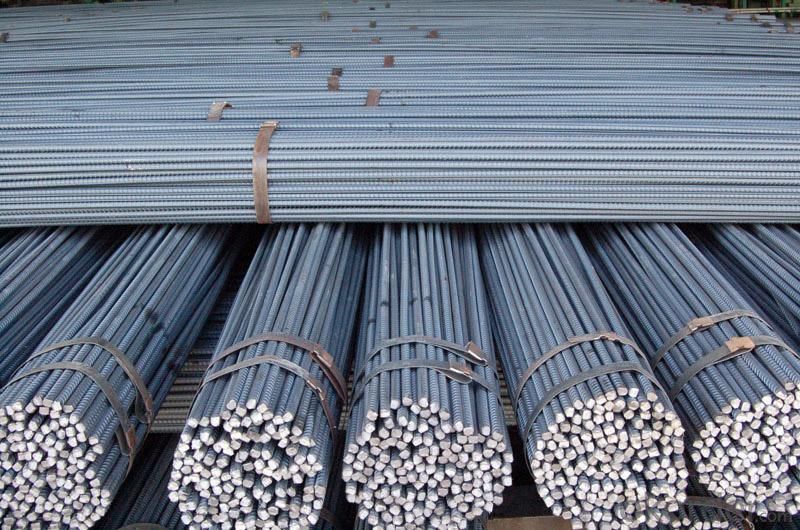
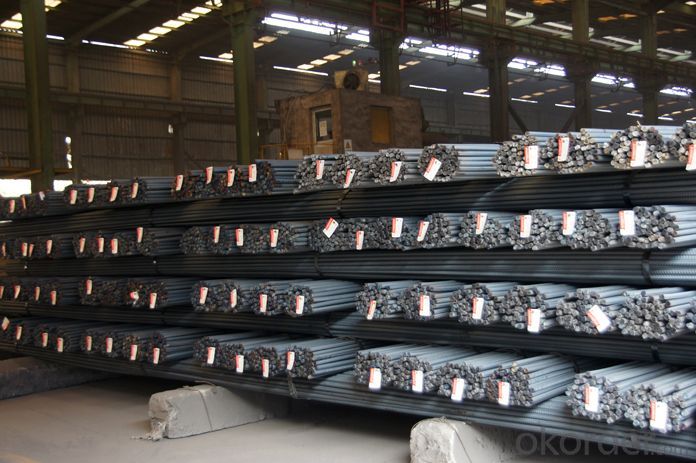
- Q:How do steel rebars affect the overall crack control of concrete?
- The incorporation of steel rebars into concrete structures is crucial for crack control. Steel rebars significantly improve the otherwise low tensile strength of concrete. Tensile forces, such as drying shrinkage, temperature changes, or applied loads, tend to cause cracks in concrete. However, the presence of steel rebars helps mitigate and control these cracks. Rebars reinforce the concrete and provide additional strength. They resist tensile forces and prevent easy cracking of the concrete. When reinforced concrete is subjected to tensile forces, the rebars bear a significant portion of the load, reducing the stress on the concrete and minimizing crack formation. The bond between the steel rebars and the concrete is essential for crack control. This bond ensures effective transfer of tensile forces to the concrete, enhancing its overall crack resistance. Additionally, the bond helps distribute applied loads evenly, reducing the risk of localized cracking. Steel rebars also have the ability to control crack widths in concrete. By specifying the appropriate diameter, spacing, and arrangement of the rebars, engineers can influence crack widths to meet design requirements. The rebars act as barriers, limiting the width of cracks and maintaining the structural integrity of the concrete. In conclusion, steel rebars have a positive impact on crack control in concrete. They enhance the tensile strength, resist tensile forces, distribute loads, and limit crack widths. Incorporating steel rebars in concrete ensures durability and longevity of structures by effectively controlling crack formation and minimizing their negative consequences.
- Q:How do steel rebars contribute to the overall sustainability of a project?
- There are several ways in which steel rebars contribute to the overall sustainability of a project. Firstly, their high durability and long lifespan mean they do not need frequent replacement, reducing resource consumption and minimizing the need for new material production. This, in turn, decreases the environmental impact of the project. Moreover, steel rebars are fully recyclable. When they reach the end of their life cycle, they can be easily collected, melted down, and repurposed into new steel products. This recycling process significantly reduces the demand for raw materials, conserves energy, and reduces landfill waste. Additionally, steel rebars provide structural strength and enhance the overall safety and resilience of the project. By reinforcing concrete structures, they increase load-bearing capacity and resistance to external forces like earthquakes or extreme weather events. This ensures the project's longevity and stability, reducing the need for future repairs or reconstruction. Lastly, the use of steel rebars in construction projects often leads to shorter construction time and lower maintenance costs. Their ease of handling and installation allows for efficient construction processes, resulting in reduced energy consumption and lower greenhouse gas emissions. Furthermore, their durability and low maintenance requirements minimize the need for ongoing repairs and replacements, resulting in cost savings over the project's lifespan. In conclusion, steel rebars contribute to the overall sustainability of a project through their durability, recyclability, and ability to enhance structural strength and safety. Their use reduces resource consumption, waste generation, and energy consumption, while also providing long-term cost savings. Incorporating steel rebars in construction projects is a sustainable choice that supports environmental conservation, economic efficiency, and social resilience.
- Q:Are steel rebars suitable for use in sports stadiums and arenas?
- Yes, steel rebars are commonly used in sports stadiums and arenas due to their strength, durability, and ability to withstand heavy loads, making them suitable for such structures.
- Q:What are the different shapes of steel rebars?
- Steel rebars, also known as reinforcing bars, come in various shapes, including round, square, and deformed. The round rebar is the most common type, while square rebars provide better grip due to their flat sides. Deformed rebars have ridges or indentations, enhancing their bond with concrete and improving structural integrity.
- Q:Can steel rebars be used in residential foundation construction?
- Indeed, residential foundation construction can incorporate steel rebars. These rebars are widely utilized in reinforced concrete structures, including residential foundations, with the intention of bolstering their robustness and longevity. To reinforce and avert cracking or structural collapse, the rebars are typically positioned in a grid formation throughout the foundation. They play a crucial role in evenly distributing the building's load and enhancing its ability to withstand diverse forces, such as soil pressure, wind, and seismic activity. Furthermore, steel rebars possess corrosion resistance and are capable of enduring severe weather conditions, thereby rendering them a dependable option for residential foundation construction.
- Q:How do steel rebars affect the acoustic properties of a structure?
- Steel rebars can have a significant impact on the acoustic properties of a structure. Due to their high density and rigidity, steel rebars can act as conductors of sound and vibrations. This means that when sound waves or vibrations encounter steel rebars, they can easily be transmitted through them, resulting in increased noise levels and reduced acoustic insulation. In terms of airborne sound transmission, steel rebars can create a direct pathway for sound waves to travel through a structure. This can lead to the amplification of sound, especially in areas where rebars are in direct contact with walls or floors. As a result, the overall acoustic quality of the structure may be compromised, causing increased noise levels and decreased speech intelligibility. Steel rebars can also affect the structure's ability to block impact or structure-borne noise. When vibrations are generated, for example, from footsteps or machinery, the rigid steel rebars can efficiently transmit these vibrations throughout the structure. This can result in the amplification and propagation of structure-borne noise, making it more perceptible in different areas of the building. To mitigate the negative effects of steel rebars on the acoustic properties of a structure, various techniques can be employed. One common method is to use acoustically decoupled materials or resilient mounts to isolate the rebars from the surrounding structure, reducing the transmission of vibrations. Additionally, incorporating sound-absorbing materials, such as acoustic panels or insulation, can help to absorb and dampen sound waves, improving the overall acoustic performance of the space. Overall, steel rebars can have a significant impact on the acoustic properties of a structure. Their high density and rigidity make them efficient conductors of sound and vibrations, potentially leading to increased noise levels and reduced acoustic insulation. Therefore, careful consideration of acoustic design and appropriate use of soundproofing measures are essential in minimizing the adverse effects of steel rebars on the acoustic quality of a building.
- Q:How are steel rebars stored and handled on construction sites?
- Steel rebars, also known as reinforcing bars, are an essential component in construction projects that require reinforced concrete structures. These rebars are typically stored and handled on construction sites in a systematic and organized manner to ensure their safety and efficient use. To begin with, steel rebars are often delivered to construction sites in bundles or bundles tied using wire or binding materials. Once the rebars are unloaded from the delivery truck, they are usually stored in designated areas known as rebar yards or cages. These areas are specifically designed to accommodate the length, size, and weight of the rebars, ensuring they are kept off the ground and protected from moisture, dirt, and any potential damage. In the rebar yard, rebars are commonly stacked horizontally and grouped according to their size, length, and grade. This arrangement facilitates easy identification and accessibility when needed for construction. Additionally, rebars are often separated by spacers or wooden blocks to prevent direct contact between them, reducing the risk of corrosion or tangling. When it comes to handling steel rebars, construction workers must prioritize safety and follow specific guidelines. Personal protective equipment, such as gloves and safety boots, should be worn to prevent injuries and ensure a secure grip on the rebars. In some cases, workers may use lifting equipment, such as cranes or forklifts, to move and transport rebars to different areas of the construction site. During transportation, rebars should be secured properly to prevent any shifting or falling, which could lead to accidents. Workers should also avoid dragging rebars on the ground, as this can cause damage to the bars or deform their shape, compromising their structural integrity. It is crucial to note that steel rebars should be inspected before use to ensure they meet the required specifications and are free from any defects. Rusty or damaged rebars should be discarded or repaired, depending on the severity of the issue. In summary, steel rebars are stored and handled on construction sites with utmost care and attention. Proper storage in designated rebar yards, correct grouping and separation, and adherence to safety guidelines during handling contribute to the successful and efficient use of steel rebars in construction projects.
- Q:What's the difference between earthquake resistant thread steel and common thread steel?
- The advantage of threaded steel is not a little at two, but a lot. Generally speaking, the anti-seismic thread steel ensures the seismic resistance of the reinforcing steel bar, so that the anti-seismic thread steel can be stable when the building is inclined or deformed, and does not break.
- Q:Can steel rebars be used in temporary structures?
- Yes, steel rebars can be used in temporary structures. They are commonly used in construction projects for their strength and durability, regardless of the structure's permanence.
- Q:Sixteen mm steel, 12 meters long, a ton, how many roots?
- The weight of that one 12m is 12*1.58=18.96kg. 1 tons =1000kg. That's 1 tons: 1000 divided by 18.96, about 52. Hope to help you.
1. Manufacturer Overview |
|
|---|---|
| Location | |
| Year Established | |
| Annual Output Value | |
| Main Markets | |
| Company Certifications | |
2. Manufacturer Certificates |
|
|---|---|
| a) Certification Name | |
| Range | |
| Reference | |
| Validity Period | |
3. Manufacturer Capability |
|
|---|---|
| a)Trade Capacity | |
| Nearest Port | |
| Export Percentage | |
| No.of Employees in Trade Department | |
| Language Spoken: | |
| b)Factory Information | |
| Factory Size: | |
| No. of Production Lines | |
| Contract Manufacturing | |
| Product Price Range | |
Send your message to us
Reinforcing Bar for Sale - High Quality Hot Rolled Rebars at Best Prices
- Loading Port:
- Tianjin
- Payment Terms:
- TT OR LC
- Min Order Qty:
- 25 m.t.
- Supply Capability:
- 10000 m.t./month
OKorder Service Pledge
OKorder Financial Service
Similar products
New products
Hot products
Hot Searches
Related keywords
